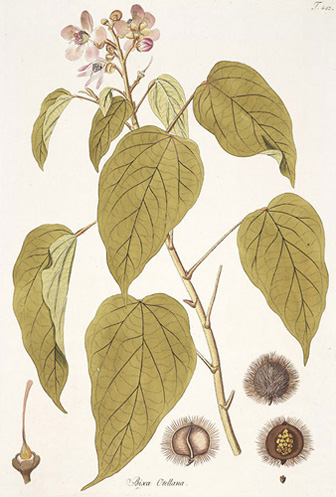Annatto Bixa orellana
From An Herbalist in the Kitchen

Illustration from:
Plantarum rariorum horti caesarei Schoenbrunnensis descriptiones et icones.
Volume: 4 of 4. Viennae: Apud C. F. Wappler; Londini: Apud B. et J. White; Lugduni Batavorum: Apud S. et J. Luchtmans, 1797-1804.
Courtesy of the Rare Book Collection of the Missouri Botanical Gardens.
Other Common or Ethnic Names
- Achiote, Bija, Bilol, Lipstick Tree
- Brazil: Urucu, Urucum
- Columbia: Achihuite
- Estonia: Varvibiksa
- Finland: Annaatto
- France: Achiote, Rocou
- French Guiana: Roucou
- Germany: Orleanstrauch
- Indonesia: Kesumba
- Italy: Annatto, Anotto
- Malaysia: Jarak Belanda, Kesumba
- Netherlands: Achiote, Anatto, Annotto, Orleaan, Rocou
- Panama: Achote
- Philippines: Achuete, Asuete, Achwete, Echuete
- Portugal: Annato
- Spain: Achiote, Achote, Annato
- Thailand: Kam Tai
- Vietnam: Hot Dieu Mau
- West Indies: Roucou
Growth Habits
Small tropical tree or shrub
Origin: Old World tropics
Range: Naturalized in New World tropics, grown in southern US
Related Species
Bixa orellana is the only species in the family Bixaceae.
Culinary Uses
Seeds used in Latin American cooking, primarily as a colorant for cooking oils. It was originally intended to be used this way as a substitute for Dende Oil (made from the seeds of the African Oil Palm, Elaesis guineensis) also known as Macaw Fat or simply Palm Oil. Dende is essential to the cooking of West Africa, Brazil and Malaysia -- but its saturated fat content is anathema to modern health-conscious dieters. Annatto-laced oil (known as Oleo do Urucum in Brazil), while it cannot duplicate the crisp-frying qualities of Palm Oil, does color, and subtly flavor, rice and -- as in the Ecuadorian soup, Locro -- potatoes.
If authenticity outweighs (if you can find it in your heart to pardon the expression) health concerns, use Palm Oil for its authentic flavor. While you're at it, go back to using lard in Mexican dishes, and Coconut Oil in Indonesian cooking, as well -- you only live once. Actually, Annatto-colored Lard is available in markets catering to Latin-American (especially Guatemalan) customers.
The seed, whole or ground, is used throughout the Caribbean, Central America and South America. In this country, the whole seeds can usually be found in Hispanic markets, or in the Hispanic section of large grocery stores. They can be ground in a pepper mill, and added to chickens and salads. Achiote is a Mexican paste consisting of ground Annatto seeds, Black Pepper, Garlic and Seville Oranges. Bijol is a commercial paste of corn, flour, cumin, artificial yellow and red dyes, and annatto used in the preparation of yellow rice in the Caribbean and in the Yucatan.
Annatto is essential to Puerto Rican cooking. Combined with Garlic, Lemon Juice, Oregano, Soy Sauce and Rum, it makes a marinade for Pollo Frito, a favorite fried chicken recipe.
The active principle in the dye is Bixin. The dye is present, in more potent form, in the aril that surrounds the seeds. The aril does not, however, have the flavor or nutty aroma of the seeds themselves.
It is used to color butter and cheeses, notably English Cheddars, "red" Cheshires and Hereford Red, a deep orange Leicester-like cheese. Other English cheeses include Bedwardine and Cloisterers, the rinds of which are washed with Annatto. In Scotland, two deep yellow cheddars are colored with Annatto: Dunlop and Mull of Kintyre. The Australian Moyarra has an Annatto-colored stripe through the center of the cheese. Our American Colby and Longhorn are pale (if deeply colored) imitations of these cheeses of British descent. France has a number of deep yellow or orange cheeses that incorporate Annatto. Saint-Albray has its rind rubbed with crushed Annatto seeds. Langres, from Champagne, is merely rinsed with Bixin-laced brine while it cures -- as is Pierrre-qui-Vire. The Burgundian La Boule de Moines is a fresh Pierrre-qui-Vire, rolled in chopped herbs. The reddish Saint-Florentine is another Annatto-colored Burgundian soft cheese. Germany's Steppenkase is colored with Annatto, while Dutch Leidens (or Leydens) have their rinds rubbed with the dark red seeds.
Aside from its use in the manufacture of cheeses, Annatto was traditionally used to color the marinade for Chinese Roast Pork -- although it would be unusual to find a Chinese charcuterie anywhere that does not use artificial food coloring, exclusively, today.
The subtle flavor of Annatto is derived from Annotta and Arnotta.
Other Uses
Cosmetics -- South American Indians make red body paints from Annatto.
Comments
Annatto stains.
